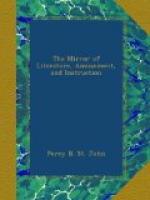Added to the charms of the romantic scenery of Clifton are the attractions of the Bristol Hot Wells, in the vicinity; upon which fashion has conferred too great celebrity to render description needful. The richness and grandeur of the scenery of the Hot Wells are almost inconceivable; in some places the rocks, venerably majestic, rise perpendicularly, or overhanging, craggy and bare; and in others they are clothed with luxuriant shrubs and stately trees. From the bottom of these cliffs, on the east bank of the river, issues the Bristol Hot Well water. The spring rises out of an aperture in the solid rocks and is computed to discharge about forty gallons in a minute.
The author of the History and Beauties of Clifton Hot Wells, in describing this scenery, says, “One of the sublimest and most beautiful scenes in nature is exhibited by those bold and rugged eminences behind the crescent, known by the name of St. Vincent’s Rocks, which appear to have been rent asunder by some violent convulsion of nature.” They are misshapen and massy projections, nearly 300 feet in height. Pieces of this rock, when broken, have much the appearance of a dark, red marble; and when struck by a substance of corresponding hardness, emit a strong sulphureous smell. It is sometimes used as a substitute for foreign marble for chimney-pieces; but principally for making lime. In the fissures of these rocks are found those fine crystals usually called Bristol stones, which are so hard as to cut glass, and sustain the action of fire and of aquafortis; this, however, is only the case with such as are tinged. The imperfect ones, in which there appears something like small hairs, white specks, or bubbles of air and water, turn white when calcined.
On these rocks, the Rev. W. Lisle Bowles has the following lines:—
How beauteous the pale rocks above the
shore
Uplift their bleak and furrow’d
aspect high!
How proudly desolate their foreheads,
hoar,
That meet the earliest sunbeam
of the sky!
Bound to yon dusky mart, with pennants
gay,
The tall bark on the winding
water’s line,
Between the river cliffs plies her hard
way,
And peering on the sight the
white sails shine.
* * * * *
LITERARY PROBLEM.
(For the Mirror.)
It is not perhaps generally known, that in the writings of Sodates, a poet of Thrace, many of the verses may be turned and read different ways, without either losing the measure or sense; for instance the following, which may be read backwards:—
“Roma tibi stibito motibus ibit
amor
Si bene te, tua laus taxat, sua laute
tenebis
Sole medere pede, ede perede, melos.”
His writings are nearly extinct, and are for the most part of a very immoral kind. He wrote some verses against Philadelphus Ptolemy, and was, in consequence, put into a cage of lead and thrown into the sea.




